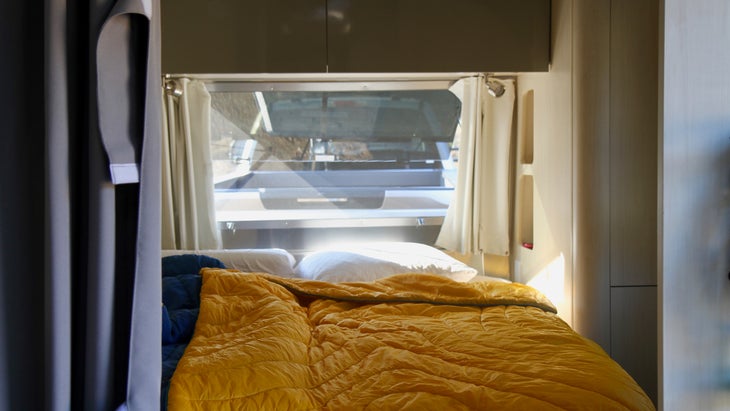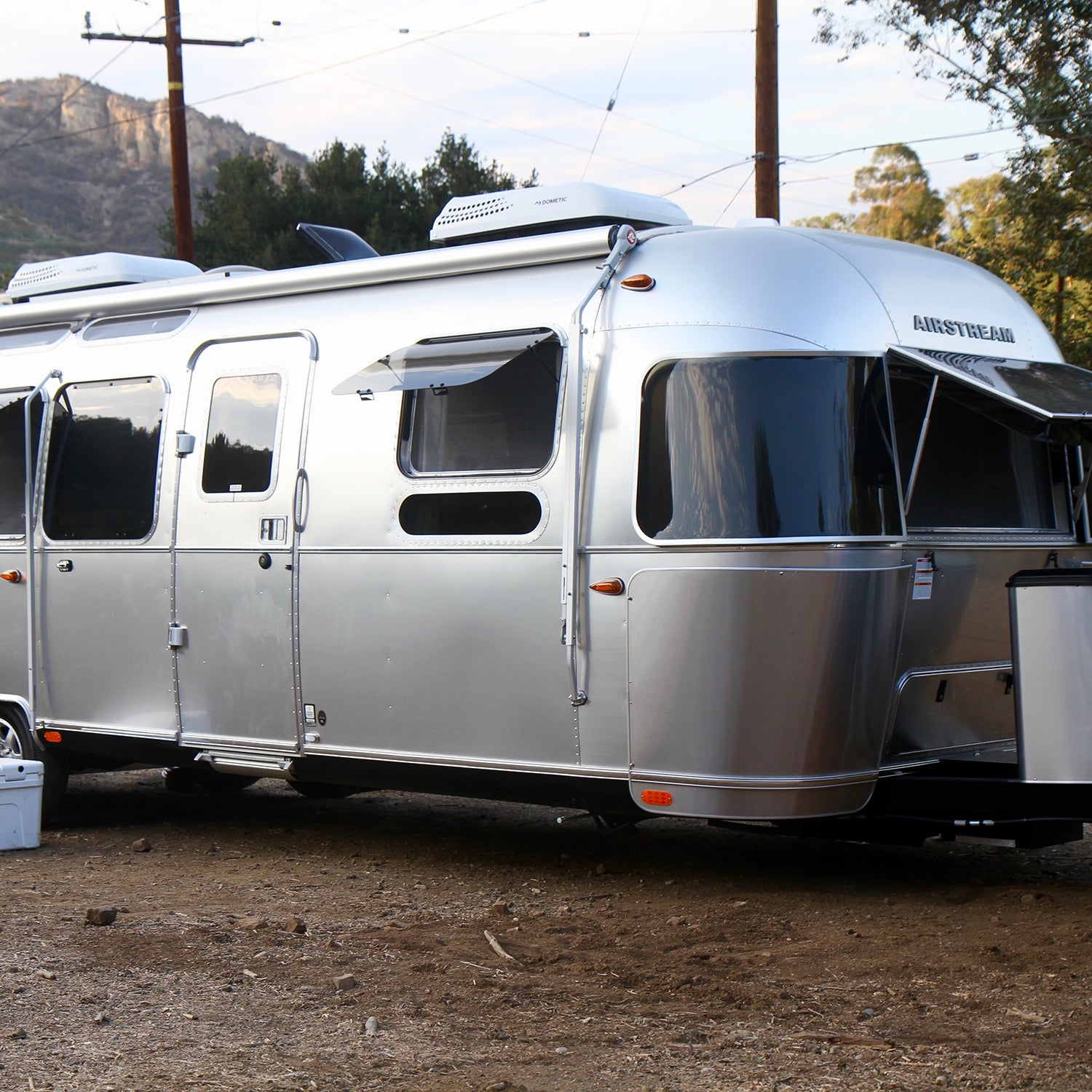When Airstream announced a trailer with a built-in mobile office earlier this year, it was perfectly positioned to generate buzz. The new model wasn’t aimed at just RV enthusiasts or the active subculture of posters at Airforums, but also at the wave of techies trading in their cramped, overpriced condos in SoMa for a life of coding while parked beneath the pines.
As we slowly emerge from a year at home spent toiling in spare nooks and converted dining rooms, this work-from-anywhere trailer offers an aspirational view of life—one of conference calls in pastures, with rambling hikes waiting outside the riveted office window. It’s fodder for #wanderlust daydreams and Pinterest boards, demanding attention from millennials who compulsively browse Redfin wondering if the native grasses really are greener.
After spending a few recent days in July with the Flying Cloud 30FB Office in the Santa Monica Mountains, I found the trailer elegant and comfortable, but the office idea proved better in theory than in practice. The behemoth 30-foot, 6,757-pound camper could be a luxurious desk on wheels, but it’s probably best used as a gleaming aluminum spare bedroom, parked somewhere on a spread of land where your daily commute amounts to ambling down a dirt path from your home.

I tested the trailer in its ideal situation: a quiet, wide-open patch of local mountain with electricity and water hookups. The plan was to work by day—making music with my mobile recording rig in the back office—with bike rides and hikes from the front door buffering the day at sunrise and sundown. It was a welcome adventure, though I didn’t end up crossing much off my to-do list.
In stark contrast to my earlier test of the BasecampX, finding a campsite for the Flying Cloud, which is nearly double the length and more than twice the weight, proved particularly difficult. It was too long for nearly every campground in my local Los Padres or Angeles national forests, and I was too unsure of the trailer’s off-road capabilities to access dispersed sites in Sequoia National Forest. (Perhaps this is why Airstream campsites like Caravan Outpost or AutoCamp have become so popular.) Eventually, I settled on a piece of private property available on Hipcamp in the mountains above Malibu, where I could find ridgeline hikes through rolling hills to sandstone peaks and some of the best road biking in California.
This was my favorite moment with the Flying Cloud—somewhere between unplugged and plugged in, cosplaying rural living but with one bar of LTE and a $110,000 trailer to retreat inside at the end of the day.
The 90-minute drive to the site put the towing to the test in a variety of circumstances: through neighborhood streets, onto one of the busiest highways in the United States, and ultimately up a winding mountain road. I’m not a stranger to towing, having hauled a 22-foot Airstream round-trip from Los Angeles to Telluride and trailers full of music gear across the country numerous times, but the Flying Cloud was a proper challenge, even pulled behind the ridiculously capable and burly Ford F-350. The length wasn’t so daunting as the width, the maneuverability, and the sway. The trailer is about 8’5″ wide, giving less than two feet of wiggle room in either direction when passing, so I found myself largely sticking to the right lane, where I had some bailout shoulder, even if it meant 18-wheelers passing me on the left or cars merging on my right. Managing the trailer’s sway meant carefully avoiding any unnecessary or sudden steering inputs and meticulously holding my line on gentle curves. Though it was a hefty rig, I suspect the ride is something I would get used to if I owned the trailer, as I watched equally wide semis pass me without hesitation. Still, towing this trailer requires more foresight and concentration than something like the BasecampX or the 22-foot Bambi, and every gas stop in the 30-footer holds the looming threat of getting stuck in a too-narrow turnaround. If I owned it, I’d want to find a good spot and leave it there for weeks or months at a time.
Towing challenges aside, settling into the Flying Cloud once it was parked was enjoyable and easy. The trailer’s floor plan has the master bedroom at the tow hitch end and the office, with adjacent bathroom and shower, at the rear. Between the two is a living space with a U-shaped dinette on one side and a galley and sofa on the other. Generous storage is spread throughout nearly every usable inch of the interior, with sturdy plywood cabinets built into the trailer’s contoured aluminum walls. I gravitated toward the convenience of the glossy, soft-close overhead cabinets lining the ceiling around the galley and bedroom and the low drawers beneath the sofa and in the office. Loads of closet and storage space remained even after filing away clothing, cooking supplies, music equipment, and camping gear for two. The galley has residential-style fixtures with an aesthetic I’d call “modern luxury condo,” including a stainless-steel stove and oven, microwave, and sink. The fridge, which runs on either propane or electric, cooled down within a few hours of hitching up.

The bedroom is a highlight, with a comfortable queen bed, dimmable lights, two built-in wardrobes, a bedside storage cubby for a phone and tablet, and large oval windows in every direction to offer fresh air at night and sunrise in the morning. There is also a privacy curtain between the bedroom and the rest of the trailer, which would be useful if you have kids sleeping in the converted beds in the galley or back office.
The office is ergonomic and efficient, flooded with light from three windows, and the space feels much bigger than it actually is—a testament to both the expansive views from the desk and good design. The cabinetry is cleverly built, with a bank of drawers and filing cabinets to the left of the desk and a tray table that folds out to make an added workspace. There is also a built-in cubby above the desk that I found useful for storing cables, headphones, and other odds and ends. A comfortable office chair glides atop a plastic floor mat and nests into a secure recessed groove under the desk when not in use. (A strap keeps the chair in place during transit.) The office also has ample lighting, a pop-up USB/AC outlet powered by the onboard battery (even without hookups), and another sound-deadening privacy curtain that would be useful for video calls.

After settling in and sending some emails from the office, I eventually landed in a blissful, specific lull that only camping can provide—fixing a flat on my bike under the shade of the awning, hemmed in by hills of California sagebrush and coast cholla, War on Drugs playing over the Airstream’s JL Audio five-speaker surround-sound system. This was my favorite moment with the Flying Cloud—somewhere between unplugged and plugged in, cosplaying rural living but with one bar of LTE and a $110,000 trailer to retreat inside at the end of the day. The sun ducked under the hill, and I cooked dinner in the spacious kitchen with the twilight peeking through the open skylight.
There were idyllic moments, but from a practical standpoint, owning a trailer this size and frequently taking it on the road would require a full-time love of tinkering. There is always something to improve, or modify, or fix, or reset. As one Airstream mechanic kindly put it, “It’s like your house going through a 7.0-magnitude earthquake every time you take this trailer down the road.”
In my case, I experienced some trouble with the air conditioning. It was short-cycling—running for about 10 minutes, blowing some cool air, and then switching off, only to switch back on another few minutes later. Both I and the Airstream dealer remained stumped on the cause, but I am open to the possibility that it was unreliable shore power from the campsite or perhaps a malfunctioning converter. The trailer’s AC draws too much power to reliably run on battery, so I settled for fans and open windows. Alas, the 103-degree temperatures outside made the trailer intolerably hot by midday, driving me and my dog down the mountain to the beaches of Malibu. To be sure, fixing your RV is part of owning it, but this did put a dent in the idealized picture I had of working remote from it year-round. The Flying Cloud oozes quality in the finishes and has a hand-built feeling that other trailers lack, but it is not immune to the bumps in the road.
Owning a trailer this size and frequently taking it on the road would require a full-time love of tinkering.
Airstream has a rich history of special editions that turn into collector’s items and inform future designs—like the newly announced Pottery Barn edition, the PanAmerica (as used by Ben Affleck in The Accountant), or the original Basecamp designed with Nissan. It’s easy to see the Flying Cloud Office in the same classic vein. There has long been demand for something like this, with dozens of threads on Airstream message boards sharing DIY office spaces, and even third-party companies that convert the trailers into offices. The Flying Cloud with bunks was already among the company’s most popular trailers, and the addition of the back office certainly enhances it for the outdoors-obsessed who work remote full-time.
On the last day of my “work” trip, I woke up early to brew a cup of coffee and watch the first specks of sun color the hills. From the trailer, I pedaled up a quiet two-lane road under sprawling oaks and laurels, then along a ridge until the sun was beating down without mercy. I reached a dead end and pointed my bike back downhill, mashing my pedals and speeding toward the trailer. I capped my morning with a rinse in the outdoor shower: a faucet and hose in a side compartment on the exterior with both hot and cold water. I was buzzing from the early morning adventure, grateful for such direct access to stoke and endorphins that I can’t easily attain from my home in the choked urban core of Los Angeles. I had some work to do, but rather than work from the trailer, I decided to head home to beat the heat. The office is a clever bit of design, and the trailer’s look remains as timeless as ever, but as with each adventure I have in an Airstream, the moments outdoors stuck with me more than anything else.

